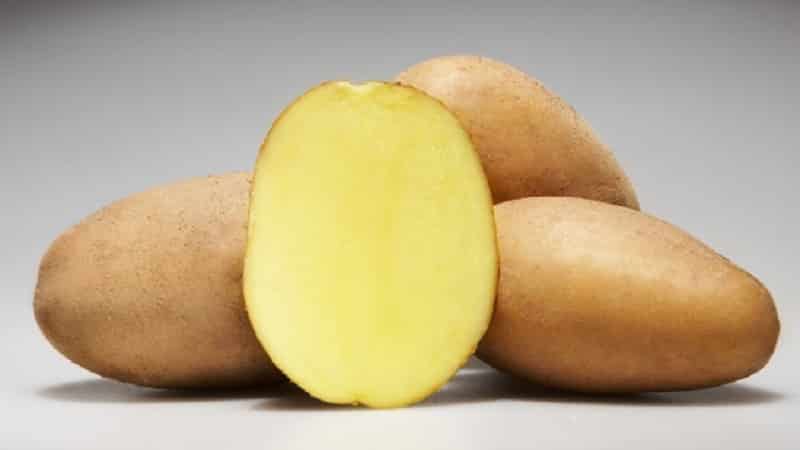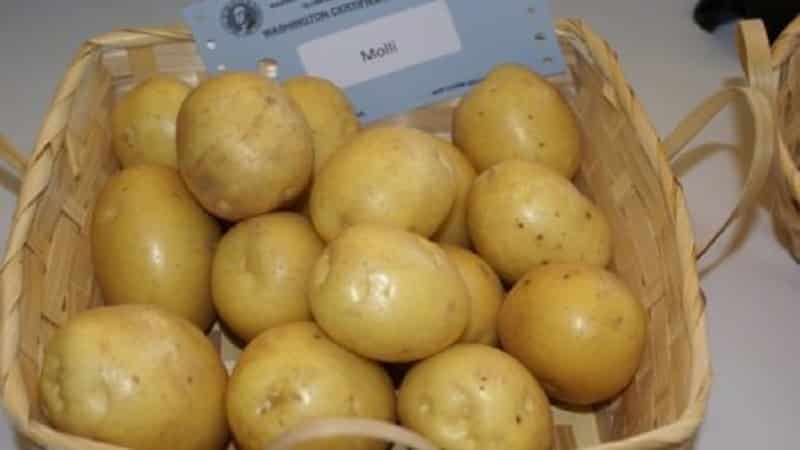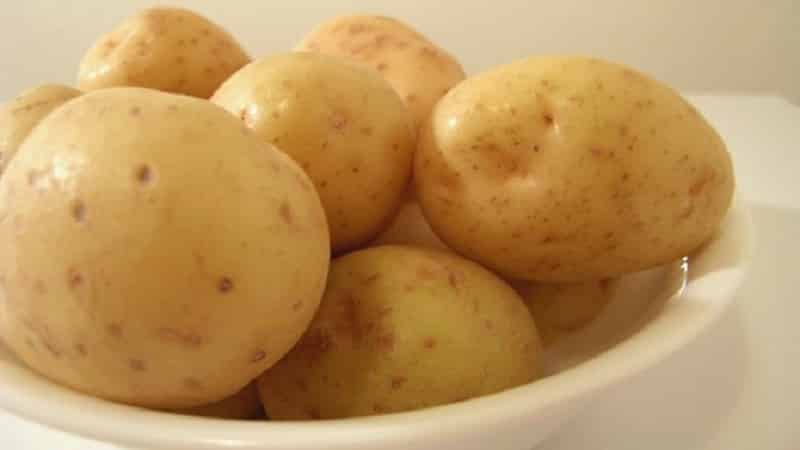Early ripening and unpretentious potato variety "Molly"
Early Molly potatoes are the result of German selection, characterized by ease of care and rapid adaptation to climatic conditions and soil type. Gardeners fell in love with the crop for the opportunity to get ripe, aromatic potatoes already in July and harvest twice a season.
We invite you to study detailed information about Molly potatoes with a description of the variety and photos.
Description of the variety and its origin
Potatoes Molly - ultra-early variety, bred by breeders of the German company Norika Nordring-Kartoffelzucht-Und Vermehrungs-GmbH. Culture was included in the State Register of Russia in 2007. The sales patent is owned by Agrofirma KRIMM LLC.
The variety has received approval for cultivation in the Central region, including Bryansk, Moscow, Kaluga, Vladimir, Ryazan, Ivanovo, Tula, and Smolensk regions.
Pictured are Molly's potatoes.

The table shows the distinctive features of the variety.
| Indicators | Characteristic |
| Ripening period | 55-65 days, first dig - in 40-45 days |
| Bush | Medium height, stem type, semi-erect to spreading |
| Number of tubers in a bush | 20-25 |
| Weight | 98-142 g |
| Form | Oval-round with small eyes |
| Coloring | The peel and pulp are yellow |
| Leaves | Medium to large in size, light green to green in color, with slight wavy edges |
| Corolla color | White |
| Starch content | 11,4-13,4% |
| Taste | Good (4 on a five-point scale) |
| Cooking class/group | A/B (light or medium crumbly) |
| Productivity | 171-308 c/ha |
| Marketability | 80-92% |
| Keeping quality | 82% |
| Purpose | Dining room |
| Sustainability | To golden nematode, cancer, Alternaria, fusarium, verticillium, common scab |
| Transportability | Average |
Chemical composition of the product
The table shows a complex of vitamins and minerals, contained in 100 g of raw tubers.
| Substance | Content | Daily norm |
| Beta carotene | 0.001 mg | 5 mg |
| Vitamin B1 | 0.081 mg | 1.5 mg |
| Vitamin B2 | 0.032 mg | 1.8 mg |
| Vitamin B4 | 12.1 mg | 500 mg |
| Vitamin B5 | 0.295 mg | 5 mg |
| Vitamin B6 | 0.298 mg | 2 mg |
| Vitamin B9 | 15 mcg | 400 mcg |
| Vitamin C | 19.7 mg | 90 mg |
| Vitamin E | 0.01 mg | 15 mg |
| Vitamin K | 2 mcg | 120 mcg |
| Vitamin PP | 1.061 mg | 20 mg |
| Potassium | 425 mg | 2500 mg |
| Calcium | 12 mg | 1000 mg |
| Magnesium | 23 mg | 400 mg |
| Sodium | 6 mg | 1300 mg |
| Phosphorus | 57 mg | 800 mg |
| Iron | 0.81 mg | 18 mg |
| Manganese | 0.153 mg | 2 mg |
| Copper | 110 mcg | 1000 mcg |
| Selenium | 0.4 mcg | 55 mcg |
| Zinc | 0.3 mg | 12 mg |
Advantages and disadvantages
Among the advantages of the Molly variety:
- early ripeness;
- drought resistance;
- adaptability to any soil;
- high productivity;
- moderate starch content;
- universal use in cooking;
- possibility of harvesting two crops.
Disadvantages: susceptibility to phytosporosis of tops and tubers, short storage period compared to late varieties.
Features of planting and growing
Molly potatoes are characterized by rapid growth of green mass with a small number of flowers. The crop is immune to drought, easily tolerates water shortages, but responds to moderate watering with an increase in yield.
The variety is suitable for growing on any type of soil after perennial grasses. In regions with cold climates, potatoes are grown under film.
Tuber preparation
Germination of tubers before landing - the procedure is optional, but significantly speeds up germination and protects against fungi and pests. Some farmers buy second- or third-generation varietal tubers from gardening stores.
For planting, select seeds weighing 50-70 g and soak them in a disinfecting solution of potassium permanganate, copper sulfate, and Fitosporin-M.
The day before planting, the tubers are treated with a growth stimulant (“Krezacin”, “Epin-Extra”, “Albit”, “Zircon”, “Immunocytofit”).
Soil requirements
Molly potatoes are not picky about the type of soil, but they show the best results when cultivated in light, nutritious soil. In the fall, the selected area is dug up, harrowed, loosened and fertilized with manure.
In spring they are sown with flax, lupine, rye, oats, and wheat. After 30 days, the grass is mowed and shallowly embedded in the soil. This enriches the soil with nitrogen and prevents the development of pathogenic microflora.
Dates, scheme and rules of planting
The timing of planting potatoes depends on the growing region. In the south, planting work is carried out at the end of April, in the north and in the middle zone - in the first and second ten days of May.
The optimal soil temperature is +10…+12°C. To protect against possible night frosts, the beds are covered with agrofibre.
The depth of planting tubers under a shovel is 5-10 cm. The gap between holes is 25-30 cm. The row spacing is 50-60 cm.
A handful of ash and superphosphate is added to each hole. To protect against wireworms, add onion peels; to repel the Colorado potato beetle, add a few peas or beans.
Care

The culture does not require a special approach to care. Agricultural technology is based on standard procedures: watering, loosening and weeding beds, hilling, fertilizing.
Despite being drought tolerant, Molly potatoes respond positively to moderate watering. To ensure a regular supply of water, drip irrigation is organized on the site. The bushes are watered manually once every 10 days.
Loosening and weeding have a beneficial effect on the health of the plant and its productivity, saturate the root system with oxygen, and facilitate the access of moisture. Weeds are removed as they appear, preventing them from taking root.
Hilling is carried out a week after planting, thereby providing protection from frost and promoting the growth of the root system. The procedure is repeated during the flowering period to stimulate tuber formation.
After the sprouts reach 12 cm in height, the bushes are fed with nitrogen, for example, a solution of chicken manure in a concentration of 1:15. During the flowering period, mineral root feeding is applied: 35 g of ammonium nitrate, 20 g of superphosphate, 10 g of potassium salt, 2 g of copper sulfate per 10 liters of water. For foliar feeding, take 25 g of urea and dissolve it in 10 liters of water. Consumption per bush - 0.5 l. They also use green fertilizers - an infusion of nettles with tomato tops: half a bucket of greens per 10 liters of water.
Disease and pest control
Molly potatoes are immune to cancer, Alternaria, Fusarium, Verticillium, and common scab, and are relatively resistant to late blight of tops and tubers.
The following will help prevent infection with late blight spores:
- pre-planting preparation of tubers - greening and germination, treatment with a solution of potassium permanganate, copper sulfate, Fitosporin-M and growth stimulants;
- compliance with the rules of crop rotation, weeding, timely harvesting of tops and tubers;
- moderate watering;
- preventive treatment with whey with iodine: 10 drops per 1 liter of fermented milk product;
- timely application of fertilizers with potassium and phosphorus.
To treat infected plants, the drugs “Oxychom”, “Ridomil Gold”, “Gamair”, “Metaxil”, “Bravo”, “Planriz”, “Alufit” are used.
The Colorado potato beetle appears in the beds when the soil warms up to a temperature of +14°C. Experienced farmers advise planting potatoes as early as possible so that the above-ground part of the plant has time to form and strengthen. Enriching the soil with fertilizers helps potatoes resist pest invasion. It is especially important to fertilize during the period of active tops formation.
If there is a slight spread of beetles in the area, they are collected manually into a 500 ml jar. Then the leaf-eaters are poured with warm water (10 l). After a week, an effective means of killing beetles is obtained based on their own poison. Spraying is carried out with a 1:2 solution wearing protective clothing and gloves.
In practice, the chemical preparations “Commander”, “Aktellik”, “Korado”, “Prestige”, “Aktara” are used. The bushes are covered with wood ash to the level of the lower leaves, marigolds, nasturtiums, peas, valerian are planted nearby, and dry lemon or orange zest is placed in the holes (the beetles do not like the smell of citrus fruits).
The fight against wireworms is carried out using:
- chemical preparations “Aktara”, “Bazudin”, “Prestige”, “Diazinon”, “Grom”, “Gromoboy”, “Zemlin”;
- adding onion peels to each well;
- watering the bushes with herbal infusion: 200 g of nettle, 100 g of dandelion and coltsfoot, 50 g of celandine are added to 5 liters of warm water and left for 24 hours.
Features of cultivation and difficulties
Molly potatoes are grown under film. An important condition is maintaining the correct temperature in the improvised greenhouse: +21...+23°C during the day and +14...+15°C at night.A decrease in soil temperature to +10°C leads to a delay in tuberization. A similar situation occurs when the air temperature rises to +30°C.
Due to their early ripeness, potatoes are cultivated under film twice a season and a high yield is obtained.. Unfortunately, the tubers are not stored for a long time, so this method is used when growing potatoes for sale and personal consumption in the summer and autumn.
Collection, storage and use of crops

Rules for harvesting early potatoes:
- Molly potatoes finish their growing season in August. By this time, the tubers are fully ripened.
- You should not keep the tubers in the ground longer than expected. When planting seeds in early May, digging begins in mid-August.
- The first digging is carried out 40-45 days after full germination.
- A week before harvesting, the tops are cut off, even if they are green. The tubers are covered with thick fabric - this way they are stored longer. If you leave them in the ground, “respiratory organs” (lentils) open on the skin, providing access to pathogenic bacteria.
- After harvesting, the tubers are allowed to “rest” for 1-2 weeks in a dry, dark place and only after that they are put into storage. Seed potatoes are left in a lighted place for gardening.
- The harvested crop is sorted, discarding damaged tubers.
The storage facility is pre-disinfected, storage containers are washed and dried. Potatoes are best stored in ventilated containers: wooden boxes, nets, burlap. The optimal temperature in the cellar is +3...+4°C, humidity is 70-80%.
Reference. After harvesting, complex biochemical changes occur in the potato, which are accompanied by the removal of excess moisture, completion of the compaction of the outer shell, and wound healing.
Due to its moderate starch content, Molly is suitable for frying, cooking, baking, stewing. The flesh does not darken after cutting. New potatoes are especially tasty with butter and herbs.
Tips and reviews from gardeners
There are only positive reviews about the Molly variety.
Nazar, Lyudinovo: “Molly potatoes are considered one of the best early German varieties. Many people do not like early-ripening crops due to their short shelf life. I’m willing to argue with this, because I keep these potatoes until spring. I put the seed material away right away, leave it in the sun to turn green, and put it in a homemade cellar. Behind the house I dug a hole 2.5 m deep and laid straw on the bottom. I lay the tubers on top and cover them with a layer of straw. In the middle there is a pipe in a vertical position for air access. The pit is covered with a wooden lid. This is how my grandmother used to store seeds. In the spring I get tubers in excellent condition, not rotten, without sprouts.”
Bogdan, Donskoy: “I like Molly potatoes for their excellent taste and ease of care. I harvest twice - in July and then in mid-August. Very tasty new potatoes with butter. I store the harvest in nets in the cellar at a temperature not exceeding +4°C.”
Read also:
Is it possible to eat potatoes if you have high cholesterol?
Conclusion
Early ripening Molly potatoes have been highly praised by farmers for their high yield, excellent taste, smooth ripening and attractive presentation. The crop is completely undemanding to soil and adapts to any climatic conditions, which is why it is grown in many regions of Russia.
To obtain a rich harvest in the northern regions, the beds are covered with agrofibre and the watering and fertilizing regime is observed. Despite all the positive qualities, the variety has two drawbacks - a predisposition to late blight and a low level of keeping quality compared to late varieties.